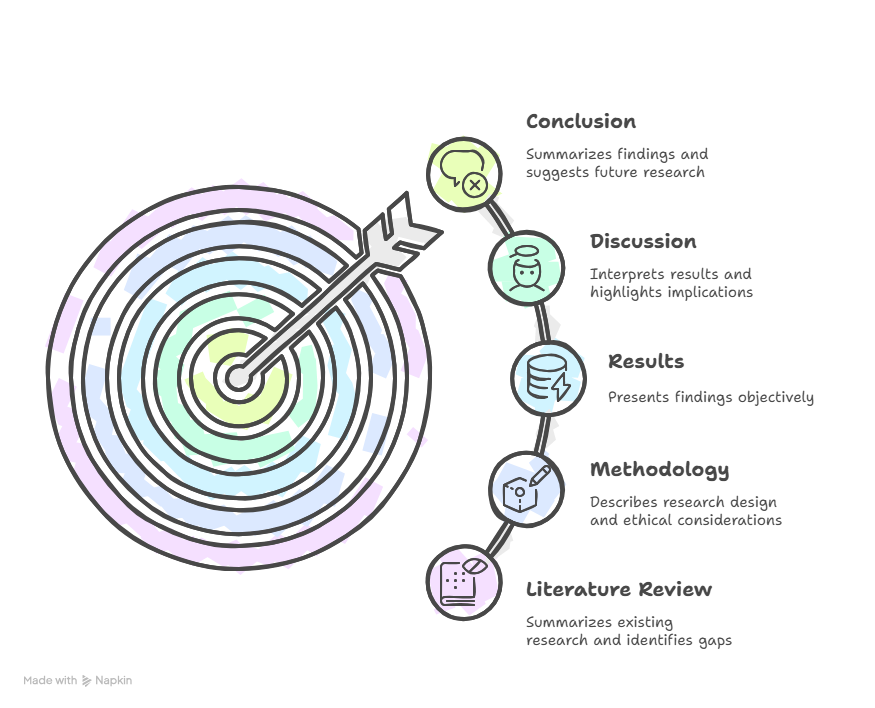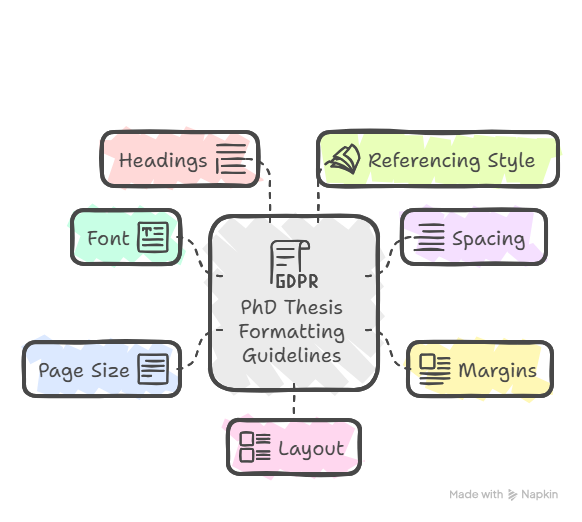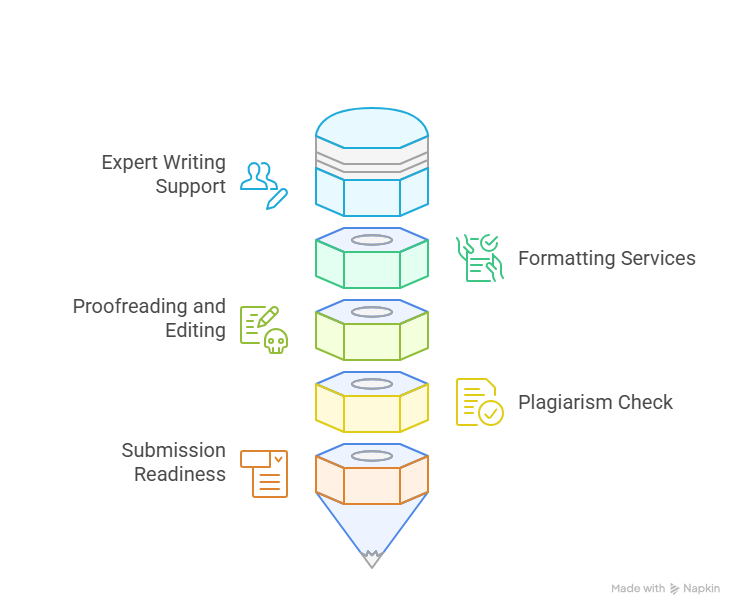Writing a PhD thesis is one of the most intellectually demanding tasks in academia. It is not just a document—it’s a reflection of years of research, critical thinking, and scholarly contribution. Following proper guidelines for PhD thesis writing ensures that your work meets institutional standards, maintains academic integrity, and communicates your findings effectively. This blog will walk you through every essential aspect of thesis writing, from pre-writing preparation to final submission, helping you avoid common pitfalls and present your research with clarity and professionalism.
Table of Contents
Why Following Proper Guidelines for PhD Thesis Writing is Crucial
PhD thesis writing is essential for ensuring your research is respected and recognized within academic circles. These guidelines serve as a framework that enhances the credibility of your work. When your thesis adheres to institutional standards, it signals to evaluators and peers that your research is methodical, well-organized, and academically sound. Universities enforce strict formatting and structural rules to maintain consistency and quality across submissions, and compliance with these rules is often a prerequisite for approval.
A professionally presented thesis reflects your dedication to scholarly excellence. It demonstrates that you’ve taken the time to structure your arguments clearly, cite sources correctly, and format your work according to academic norms. This attention to detail can significantly reduce the likelihood of your thesis being returned for revisions, saving time and effort.
Moreover, following ethical writing practices—such as proper citation and avoiding plagiarism—is a cornerstone of academic integrity. These practices not only protect your work from ethical scrutiny but also build trust in your findings. In short, respecting the guidelines for PhD thesis writing is not just about meeting requirements—it’s about showcasing your research in the most credible and impactful way possible.
Pre-Writing Checklist: What to Finalize Before You Start Writing
Topic Confirmation
Before beginning your thesis, it’s essential to finalize your research topic. This topic must be approved by your supervisor and should align with your department’s research priorities. A well-defined topic ensures clarity in your research objectives and helps you stay focused throughout the writing process. Choosing a topic that is both relevant and researchable is the foundation of following the guidelines for PhD thesis writing.
Data Collection
All necessary data—whether experimental results, survey responses, or archival materials—should be collected before you start writing. This ensures that your arguments are based on complete evidence and that you won’t face interruptions later. Having your data ready also allows you to structure your chapters more effectively and maintain logical flow.
Supervisor Feedback
Regular meetings with your supervisor are crucial. Their feedback helps refine your research questions, methodology, and theoretical framework. Early and consistent input prevents major revisions later and ensures your work aligns with academic expectations. This step is vital for adhering to the guidelines for PhD thesis writing.
Ethics Clearance
If your research involves human participants, animals, or sensitive data, you must obtain ethics clearance from your university’s ethics committee. This approval is not just a formality—it’s a requirement that upholds the integrity of your research and ensures compliance with institutional and legal standards.
Literature Review Notes
Before writing, organize your literature review notes. This includes summarizing key studies, identifying research gaps, and compiling references. A well-prepared literature base supports your arguments and helps you cite sources correctly, which is a core part of the guidelines for PhD thesis writing.
Structuring Your PhD Thesis: Chapter-Wise Breakdown
Introduction
The introduction sets the stage for your research. Begin by clearly defining the research problem—what issue are you addressing and why it matters. Then, state your research objectives and explain the significance of your study in the broader academic or practical context. Provide a clear roadmap of your thesis by summarizing each chapter to help readers navigate This chapter must align with the guidelines for PhD thesis writing by being concise, focused, and logically organized.
Literature Review
This chapter summarizes existing research relevant to your topic. Highlight key theories, methodologies, and findings from previous studies. Identify gaps in the literature that your research aims to fill. Justify your theoretical framework by explaining why it’s suitable for your study. An organized literature review showcases your grasp of existing research and strengthens the foundation of your study.
Methodology
Describe your research design—qualitative, quantitative, or mixed methods. Explain how you collected and analyzed data, including tools, techniques, and procedures. Discuss any limitations and ethical considerations, especially if your study involves human or animal subjects. This chapter must be detailed and transparent, as per the guidelines for PhD thesis writing, to allow replication and validation.
Results
Present your findings using tables, graphs, and charts. Focus on raw data without interpretation. Organize results logically, often by research question or hypothesis. This chapter should be clear and objective, allowing readers to see the evidence before conclusions are drawn.
Discussion
Interpret your results in the context of the literature reviewed earlier. Highlight the implications of your findings, contributions to the field, and how they address the research problem. Discuss limitations and suggest areas for future research. This chapter bridges your findings with broader academic discourse.
Conclusion
Summarize the key findings of your research. Emphasize the importance of your research and highlight the value it adds to the academic field. Suggest future research directions based on your results and limitations. A strong conclusion reinforces the value of your work and aligns with the guidelines for PhD thesis writing by providing closure and clarity.
Formatting Guidelines for PhD Thesis Writing in Indian Universities
Font
Use Times New Roman throughout your thesis. The standard font size is 12 for body text and 14 for headings. This classic serif font ensures readability and maintains a formal academic tone.
Spacing
Maintain 1.5 line spacing across all chapters, including the bibliography and appendices. This spacing improves readability and allows room for annotations during review.
Margins
Set your margins as follows:
- Top: 30–35 mm
- Bottom: 25–30 mm
- Left: 35–40 mm (to allow binding space)
- Right: 20–25 mm
These dimensions ensure that your thesis is print-ready and conforms to binding requirements.
Page Size
Use A4 size paper (297 mm x 210 mm), which is the standard for academic submissions in India. Ensure all pages are uniformly sized and properly aligned.
Headings
Headings should be bold, capitalized, and centered. This formatting helps distinguish sections clearly and adds to the professional layout of your thesis.
Referencing Style
Follow the referencing style prescribed by your university—commonly APA, MLA, or IEEE. Consistency in citation format is crucial for academic credibility and avoiding plagiarism. Referencing is a key component of the guidelines for PhD thesis writing.
Layout
Your thesis should include the following sections in order:
- Title Page
- Certificates (Supervisor and Institutional)
- Declaration
- Abstract
- Table of Contents
- Chapters (Introduction to Conclusion)
- Bibliography
- Appendices
- Plagiarism Report
Each section must begin on a new page and be properly labeled. This structured layout ensures clarity and meets institutional expectations.
Referencing and Citation Guidelines: APA, MLA, IEEE, and More
APA Style
Widely used in the social sciences, APA (American Psychological Association) style follows an author-date format. For example:
In-text citation: (Smith, 2020)
Bibliography: Smith, J. (2020). Title of the book. Publisher.
APA emphasizes clarity and conciseness, making it ideal for psychology, education, and sociology research.
MLA Style
The Modern Language Association (MLA) style is common in humanities disciplines like literature and philosophy. It uses an author-page format.
Bibliography: Smith, John. Title of the Book. Publisher, 2020.
MLA focuses on detailed source documentation and is preferred for textual analysis.
IEEE Style
The Institute of Electrical and Electronics Engineers (IEEE) style is used in engineering and technical fields. It employs numbered citations in square brackets.
In-text citation: [1]
Bibliography: [1] J. Smith, Title of the Book, Publisher, 2020.
IEEE is concise and efficient, suitable for technical writing with numerous references.
General Guidelines
- In-text citations must match the corresponding entries in the bibliography exactly.
- The bibliography should be arranged alphabetically (APA/MLA) or numerically (IEEE), and formatted according to the chosen style.
- Consistency in citation style throughout the thesis is crucial and is a core part of the guidelines for PhD thesis writing.
Plagiarism Check and Ethical Writing Practices
Originality Matters
Universities across India require a similarity index below 25% for PhD thesis submissions. This benchmark ensures that your work is original and not copied from existing sources. High similarity scores can lead to rejection or mandatory revisions, delaying your academic progress.
Use Detection Tools
To maintain originality, use plagiarism detection tools like Turnitin, Urkund, and Grammarly. These tools scan your document against vast databases and highlight potential overlaps. Regular checks during the writing process help you stay within acceptable limits and follow the guidelines for PhD thesis writing.
Proper Paraphrasing
Instead of copying text, paraphrase ideas in your own words and cite the original source. This demonstrates your understanding of the material and avoids plagiarism. Effective paraphrasing is a skill that strengthens your academic writing and supports ethical scholarship.
Avoid Self-Plagiarism
Reusing your previous work without proper citation or disclosure is considered self-plagiarism. If you must include earlier research, clearly reference it and explain its relevance to your current thesis.
Ethical Reporting
Always present your data truthfully. Fabricating or manipulating results violates ethical standards and can lead to serious academic consequences. Transparency in methodology and findings is a core principle of the guidelines for PhD thesis writing.
Common Mistakes to Avoid in PhD Thesis Writing
Inconsistent Arguments
Ensure that your thesis follows a logical progression. Each chapter should build upon the previous one, leading to a coherent conclusion. Disjointed arguments confuse readers and weaken your research impact.
Poor Formatting
Ignoring formatting rules can result in your thesis being rejected or returned for corrections. Follow university-specific formatting guidelines for fonts, margins, spacing, and layout to maintain professionalism.
Weak Conclusions
A strong conclusion reinforces your findings and highlights the significance of your research. Avoid vague or generic summaries. Instead, clearly state how your work contributes to the field and suggest future research directions.
Overuse of Quotes
While quoting sources is acceptable, excessive use can dilute your voice. Paraphrase where possible and use quotes only when the original wording is essential. This keeps your writing original and engaging.
Ignoring Feedback
Supervisor feedback is invaluable. Dismissing suggestions or failing to revise your work can lead to major issues during evaluation. Incorporate feedback diligently to improve clarity, structure, and content.
How PhDiZone Helps You Follow Every Thesis Guideline Flawlessly
PhDiZone plays a vital role in helping scholars meet the guidelines for PhD thesis writing with precision and confidence. Their comprehensive support system ensures that every stage of your thesis—from drafting to submission—is handled with academic rigor and professional care.
Expert Writing Support
PhDiZone offers expert academic writing assistance tailored to your research domain. Their writers help you structure your thesis logically, refine your arguments, and maintain scholarly clarity. This support is especially valuable when aligning your work with the guidelines for PhD thesis writing, ensuring that your research problem, objectives, and findings are clearly articulated.
Formatting Services
Formatting is a critical part of thesis presentation. PhDiZone ensures your document adheres to university-specific formatting standards, including font style, spacing, margins, and layout. By following the guidelines for PhD thesis writing, they help you avoid technical errors that could delay approval or require revisions.
Proofreading and Editing
Even well-researched theses can suffer from grammatical mistakes or inconsistent tone. PhDiZone’s proofreading and editing services enhance readability, correct language issues, and ensure your writing style is formal and academic. This step is essential for meeting the guidelines for PhD thesis writing and presenting a polished final document.
Plagiarism Check
Maintaining originality is a cornerstone of ethical research. PhDiZone uses trusted plagiarism detection tools like Turnitin and Grammarly to scan your thesis and provide detailed similarity reports. They also guide you in proper paraphrasing and citation, helping you stay within the acceptable limits defined by the guidelines for PhD thesis writing.
Submission Readiness
PhDiZone prepares your thesis for final submission by conducting a thorough review. They verify formatting, check citations, ensure chapter alignment, and package your document according to university protocols. Their end-to-end support ensures your thesis is complete, compliant, and ready for evaluation.
FAQ
1. What are the basic guidelines for PhD thesis writing in Indian universities?
Indian universities typically require specific formatting standards such as Times New Roman font, 1.5 line spacing, defined margin sizes, and structured chapters. Following these guidelines ensures your thesis meets institutional expectations.
2. How long should a PhD thesis be?
The length varies by discipline, but most Indian universities expect a thesis to be between 150 to 300 pages, excluding appendices and references. Always check the specific guidelines for PhD thesis writing provided by your institution.
3. Which referencing style should I use in my PhD thesis?
The referencing style depends on your field of study. APA is common in social sciences, MLA in humanities, and IEEE in engineering. Refer to your university’s official guidelines for PhD thesis writing to choose the correct style.
4. What is the acceptable plagiarism percentage for a PhD thesis?
Most universities in India require a similarity index below 25%. Using tools helps ensure compliance with ethical writing practices and the guidelines for PhD thesis writing.
5. Can I include previously published work in my thesis?
Yes, but you must cite it properly and disclose its prior publication. Reusing your own work without citation is considered self-plagiarism and violates the guidelines for PhD thesis writing.
6. How important is supervisor feedback during thesis writing?
Supervisor feedback is crucial. It helps refine your research direction, improve clarity, and ensure your thesis aligns with academic standards. Regular consultations are part of best practices in thesis development.
7. What tools can help with formatting and editing my thesis?
Tools like Grammarly and MS Word’s formatting features can assist with editing and layout. Services like PhDiZone also help ensure your thesis meets all formatting guidelines for PhD thesis writing.
8. What should be included in the final thesis submission package?
Your submission should include the title page, certificates, declaration, abstract, chapters, bibliography, appendices, and a plagiarism report. These components are standard in the guidelines for PhD thesis writing.
9. How do I ensure my thesis is submission-ready?
Conduct a final review for formatting, citations, grammar, and structure. Services like PhDiZone offer comprehensive checks to ensure your thesis is fully compliant with university guidelines for PhD thesis writing.
10. What are common mistakes to avoid in PhD thesis writing?
Avoid inconsistent arguments, poor formatting, weak conclusions, excessive quoting, and ignoring supervisor feedback. These errors can delay approval and compromise the quality of your thesis.
Conclusion
Writing a PhD thesis is a monumental task, but following the guidelines for PhD thesis writing makes the journey smoother and more rewarding. From structuring your chapters to formatting your pages, every detail matters. By adhering to academic standards, you not only enhance the quality of your work but also uphold the integrity of scholarly research. Whether you’re just starting or nearing submission, this guide ensures you’re on the right track toward academic success.











